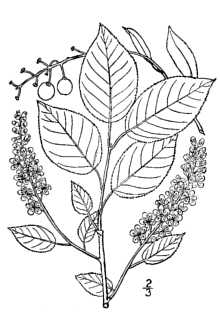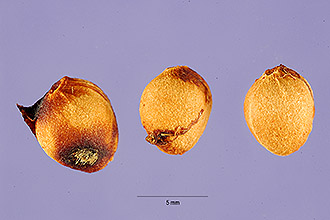Black Chokecherry
Scientific Name: Prunus virginiana L. var. melanocarpa (A. Nelson) Sarg.

| General Information | |
|---|---|
| Usda Symbol | PRVIM |
| Group | Dicot |
| Life Cycle | Perennial |
| Growth Habits | ShrubTree, |
| Native Locations | PRVIM |
Plant Guide
Use a soil moisture meter to monitor the soil moisture where Black Chokecherry is planted.
Fact Sheet
Alternate Names
Chokecherry, common chokecherry.
Uses
Black chokecherry is a valuable plant for providing not just food, but shelter, cover, and nesting habitat for wildlife. Its fruit is readily sought out by bear, birds, rabbits, rodents, and small mammals. The young immature plants are desirable to deer, elk, moose, bear, bighorn sheep, and pronghorn during the spring as well as winter months. During the spring months, while in bloom, black chokecherry provides an excellent source of nectar for many pollinators such as ants, butterflies, honeybees, flies, and hummingbirds. Black chokecherry is used in urban landscaping enhancement plantings, range and mined land reclamation plantings, shelterbelts, and windbreaks. Its extensive root system is beneficial in reducing and controlling soil erosion in rangelands and mine land reclamation. In most windbreaks, chokecherry is a good shrub to be used in the outside rows. Its dense growth makes it ideal for reducing wind near the ground surface. Native American tribes used black chokecherry for many medicinal uses. The chokecherry fruit was used for canker sores, sore throats, sore eyes, and diarrhea. The bark of the plant was used for diarrhea as well. Roots from chokecherry were dried, chewed, and placed in wounds to prevent further bleeding. The stems were boiled to make a strong tea to treat high fevers.
Status
Please consult the PLANTS Web site and your State Department of Natural Resources for this plant’s current status.
Description and Adaptation
Adaptation , Use soil moisture sensors to measure the soil moisture of Black Chokecherry.
Adaptation
Black chokecherry is a native colonizing, horizontal branching, rhizomatous, perennial shrub and/or small tree. Its main stem system may be single or may have multiple stems branching at the base. Twigs are slender with prominent red to white lenticels; the bark is greenish at first and later becomes reddish-brown. As the shrub matures the bark becomes grey to black. The root system consists of shallow rhizomes which contribute to its sprouting and rapid colonization. Leaves are alternate, simple, glabrous and elliptic ranging from 2 – 4 inches long and 1 - 2 inches wide with serrate margins. At the apex of the leaf petiole, two glands 1 – 2 centimeters long are visible. The flowers are showy white aromatic racemes with five petals. The corolla is one-half inch in diameter. Mature fruit, approximately one-third inch in diameter, are fleshy drupes that are dark red to black and possess an acidulous taste. The fleshy outer layer of the fruit is nontoxic. However, poisoning and death have occurred in children who have consumed large amounts of berries without removing the stones/seed. The stone possesses high levels of hydrogen cyanide (HCN) or prussic acid. Seed should be collected in mid-August to mid-September. Black chokecherry is a large vigorous shrub, with mature plants reaching an average height of 12 feet and about 13.5 feet wide. Black chokecherry begins flowering in May and the fruit is ripe in mid to late August. It can be found throughout Canada, south to Georgia, west to New Mexico, and California at elevations ranging from 500 – 10,000 feet. In Colorado it can be found at elevations of 4500 – 9000 feet. This species can be found along streambanks, drainages, gullies, sheltered hill slopes, and canyon bottoms. It is well adapted to soil types that range from Entisols to Mollisols that have soil textures ranging from sandy loams to clays. It can tolerate moderately acidic (pH 3.5), moderately basic (pH 7.6) and weakly saline soils. However, it cannot tolerate soils that are poorly drained or suffer from prolonged flooding periods. It is well suited in sites that receive 12 to 30 inches of precipitation annually.
Establishment
Black chokecherry can be established with seed planted about ¼ of an inch deep in the fall months or with container grown plants set in the ground in early spring when soil moisture is present. Sprouting does occur. Establishment can be slow, especially if soil moisture is low. New plantings can require several years (7 to 10) for flowering and seed production. Protection from browsing and plant competition along with the use of mulch will reduce the time required for establishment.
Management
After seeding or planting live plants, controlling wildlife browsing will be important for maintaining vigorous growth and fruit production. Reducing plant competition is also necessary for rapid plant growth. Once established, the plant can withstand moderate to heavy browsing in years with average to above average precipitation. Colorow 1 Germplasm has displayed minor aggressive behavior because of rhizomatous roots. Some routine management may be required to control and maintain this plant species in an agronomic, horticultural or home landscaping application, but control practices are financially feasible and practical. No specific management is anticipated in range or large landscape plantings where the species naturally occurs.
Pests and Potential Problems
The plant can occasionally be a host of ugly nest caterpillars. No other serious diseases or pests are known.
Environmental Concerns
Black chokecherry is an important provider of food, shelter, nesting, and browse for wildlife. However, it has been documented that livestock, primarily cattle and sheep, are very susceptible to poisoning when grazing on black chokecherry. Lethal doses occur when an animal ingests 0.25% of their body weight in an hour or less. Black chokecherry produces toxic levels of hydrogen cyanide (HCN) or prussic acid in the plant’s bark, leaves, stems, and stone/seed pit. HCN is produced enzymatically from cyanogenic glycosides when plant tissue is fragmented during mastication, rumination, and frost damage. Leaves of chokecherry are especially toxic in spring and summer, but poisoning is not likely to occur then because the chokecherry is not relished by cattle and sheep when more palatable forage is abundant. Black chokecherry does display minor aggressive behavior because of rhizomatous roots. Some routine management may be required to control and maintain this plant species in an agronomic, horticultural or home landscaping application, but control practices are financially feasible and practical. No specific management is anticipated in range or large landscape plantings where the species naturally occurs. Cultivars, Improved, and Selected Materials (and area of origin) Colorow Germplasm black chokecherry is the only release of the sub-species. Seed and plants of Colorow Germplasm are available from Upper Colorado Environmental Plant Center (UCEPC), Meeker, Colorado. 1 Chief Colorow Ignacio Ouray Walkara (1808 - 1855) was a Native American leader of a Ute Timpanogo band. The Timpanogo band was also known as the Yampa band, their boundaries encompassed the entire Yampa River. He had a reputation as a diplomat, horseman, warrior, and military leader. Prepared By: Heather R Plumb, Plant Scientist-Range Plants (UCEPC) Meeker, Colorado. Species Coordinator: Heather R Plumb

